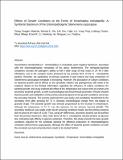| dc.description.abstract | Xenorhabdus nematophila (X . nematophila) is a mutualistic gram negative bacterium, associated with the entomopathogenic nematodes of the genus Steinernema. The nematode-bacterial complexes increase the pathogen's ability to kill a wide range of host insect in 24–48 h after infestation, due to the complex toxins produced by the primary form of the X . nematophila bacteria. Recently, the application of primary bacterial in pest control and mass production of Steinernema carpocapsae nematode is increasing. However, the association of culture conditions on bacterial growth and its effects on the symbiotic relation and pathogenicity still needs to be explored. Based on the limited information regarding the influence of culture conditions for bacterial growth, this study explored the effect of pH, temperature and culture time on primary and secondary bacterial growth, as well as physiological and biochemical parameters. Results showed that the growth and metabolism of the primary bacteria depend on the growth conditions more than the secondary bacteria. The primary bacterial form was easily and completely transformed to the secondary form after growing for 72 h, showing morphological change from rod-shaped to granular shape. The bacterial growth was directly proportional to the increase in temperature, although the temperature of 25 °C was the optimum for the primary bacteria growth. The secondary bacterium was stable under all pH growing conditions tested, but the primary bacteria did not grow at pH value of 5.166. Thus, using pH differences, secondary bacteria can be purified from the primary bacterium. Also, both forms of the X. nematophila reacted positive on glucose test, indicating high affinity to glucose substrates. Therefore, this study presents the basic growth conditions required for the symbiotic bacteria for effective production of entomopathogenic nematode (Steinernema carpocapsae), although the effect of bacterial growth conditions on both the nematode survival and productions needs to be studied further. | en_US |

